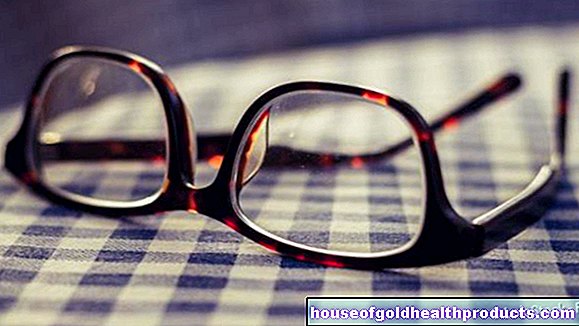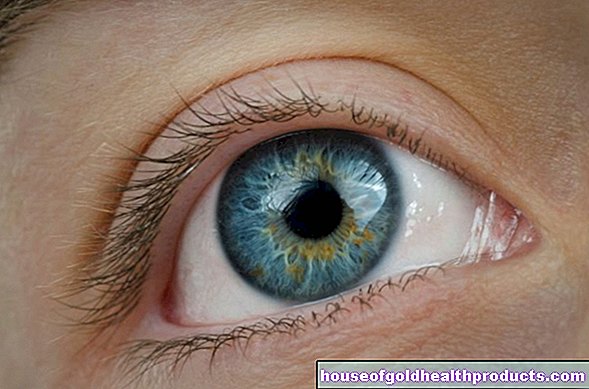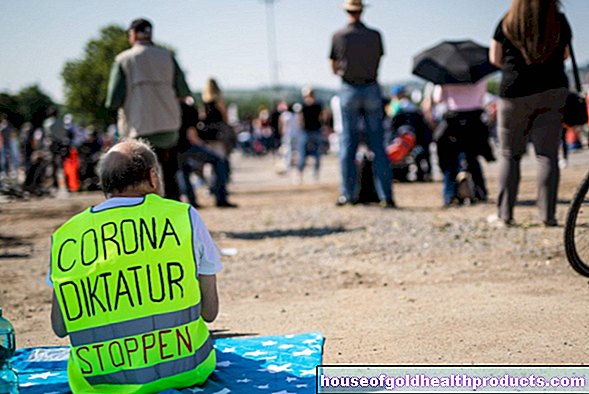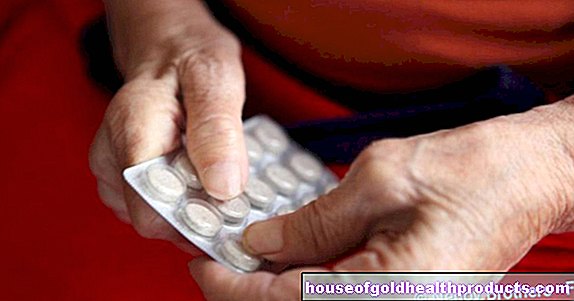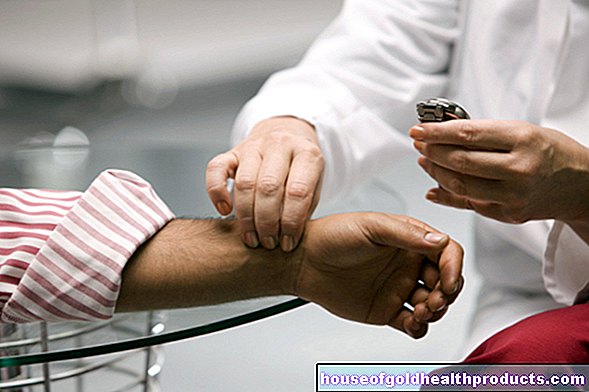Distortion
Sophie Matzik is a freelance writer for the medical team.
More about the experts All content is checked by medical journalists.A distortion (sprain) is an injury to the ligaments or joint capsule that is associated with severe pain and limited mobility of the joint. Most often, a distortion occurs in the context of sports accidents. Most of the time, the ankle, knee, or wrist are affected by a distortion. If a distortion is treated correctly and the joint is sufficiently spared, it will heal completely within a few days to weeks. However, permanent joint instability can remain. Read everything you need to know about distortion here.
ICD codes for this disease: ICD codes are internationally recognized codes for medical diagnoses. They can be found, for example, in doctor's letters or on certificates of incapacity for work. S33S83S93T03S13
Distortion: description
A sprain is an injury to the ligaments or the joint capsule. Usually it is caused by twisting the joint. The ligaments serve to stabilize the joints. They guide the movement and ensure that the joint only moves to a certain extent. The ligaments are made of elastic collagen fibers. However, if the tension on the fibers is too strong, the ligaments are overstretched and the tissue is damaged. Since smaller blood vessels in the capsule often tear when a sprain occurs, severe swelling and bruising develop at the site of the injury.
A sprain is difficult to distinguish from a stretched or torn ligament. The doctor cannot make an accurate diagnosis based on the symptoms alone. Doctors therefore often take the term sprain a little wider and define ligament stretching and ligament rupture as a sub-form of sprains:
- Grade 1 (slight distortion): Overstretching of the ligaments without instability and without structural damage to the ligaments
- Grade 2 (moderate distortion = ligament stretching): Severe overstretching or partial tearing of one or more ligaments, also without joint instability
- Grade 3 (severe distortion = ligament tear): Tear of one or more ligaments with joint instability
A distortion can occur in any joint in the body. The knee and ankle joint are particularly often affected by a distortion. Wrist and fingers are slightly less likely to be injured. A distortion in the elbow or shoulder hardly ever occurs.
Ankle distortion is the most common of all ligament injuries. It occurs mainly in sports in which the legs are used to perform quick and often very powerful movements, such as football or skiing. Distortion can also occur in normal everyday life, for example when you run down stairs too fast or when you are walking on uneven terrain. It can quickly happen that you bend over and suffer a distortion.
Doctors subdivide the ankle joint distortion into different sub-forms, depending on which ligaments of the joint are affected. Of all sports injuries, supination trauma is the most common. Doctors call supination trauma the classic "twisting an ankle", in which the sole of the foot folds inwards (towards the other foot). The outer ligament is overstretched. Colloquially, the injury is referred to as a "sprained ankle".
Another form of distortion is cervical spine distortion, in which the cervical spine is dislocated by the application of strong force. A cervical spine distortion occurs much less often than an ankle joint distortion. The cause is often whiplash, for example in a car accident. In the case of a cervical spine distortion, important nerves and vessels can be pinched and damaged as a result. Therefore, it must always be examined by a doctor as soon as possible.
As a first step in treatment, you should always cool the affected area immediately and, ideally, keep it elevated. Distortions that occur in everyday life should also be examined by a doctor (family doctor, trauma surgeon or orthopedist). Usually only a doctor can reliably assess the severity of a distortion, mainly because the severity of the injury does not necessarily correlate with the severity of the pain. In this way, even more severe injuries can cause comparatively little pain. An untreated distortion can cause irreparable damage to the joint.
Distortion: symptoms
A sprain is usually very painful. The injured usually notice immediately during or after the injury that they have sustained a distortion. Sometimes the affected joint can no longer move properly and it swells up after a short time. If blood vessels are torn, there is also a bruise (hematoma) on the injured area.
If a distortion is inadequately treated, it may heal poorly and the joint may be less stable in the future. For example, if you have an unstable ankle, you twist more often and you are much less confident when walking. If the ligaments are repeatedly overstretched, they gradually wear out. The result is a so-called "slippery joint" that has little or no stability of its own. The risk of kinking again increases considerably. Since the joint is no longer limited in its range of motion by the stabilizing ligaments and the joint capsule, it can become misaligned under stress, which over time leads to premature joint wear (osteoarthritis).
With a cervical spine distortion, there are other symptoms in addition to severe pain. These include a feeling of stiffness in the neck, headache, and dizziness. The severity of the symptoms will depend on the severity of the injury. In the case of severe distortion, swallowing disorders, sleep disorders, visual and hearing disorders as well as tingling sensations in the face or arms can also occur. These symptoms occur when nerves and blood vessels in the neck area can become squeezed. In very severe cases, pronounced neurological symptoms such as unsteadiness of walking or speech disorders occur. They occur when the vessels supplying the brain (vertebral arteries) have been damaged by the distortion and the brain stem and the cerebellum receive too little oxygen-rich blood.
Distortion: causes and risk factors
A distortion is usually caused by unusual, fast and powerful movements in which individual ligaments are stretched beyond the normal extent. A classic for the ankle joint distortion is the "twisting", in which the sole of the foot is folded inwards and the outer ligament on the ankle is thus strongly stretched (supination trauma). A distortion in the knee joint occurs when the knee is jerked outwards, for example. Distortions are particularly common in fast-paced sports such as soccer, handball, volleyball or basketball. But they can also occur in everyday life when walking or climbing stairs.
A distortion in the shoulder, elbow or finger joints is very rare. They can also be drawn in while exercising, falling or making awkward movements. A shoulder distortion can also occur if you lift unusually heavily. A thumb twist is common when skiing, for example: if the thumb gets caught in the loop of the ski pole when falling, the outer ligament is overstretched. In most cases it will tear. A so-called skier's thumb is created.
A cervical spine (cervical spine) distortion is caused by whiplash injuries such as those that occur in traffic accidents. The risk of cervical spine distortion is particularly high in a rear-end collision. A cervical spine distortion can also occur in sports and leisure accidents.
In rare cases, genetic connective tissue diseases (e.g. Marfan syndrome, Ehlers-Danlos syndrome) can lead to excessive elasticity of the ligaments and thus to joint instability. People with these conditions are at increased risk of distortion and dislocation (dislocation) of joints.
Distorsion: examinations and diagnosis
An orthopedic surgeon or trauma surgeon is the right contact in the event of a distortion or suspicion of another injury to the joints. If in doubt, you can also see your general practitioner. If there is a slight distortion, he can splint the joint and give you tips on how to behave in the near future. If you have a severe distortion, he will refer you to a specialist.
The description of your current symptoms and any previous illnesses provides the doctor with important information. In this anamnesis interview, you should report as precisely as possible how the accident or injury occurred. To get more clues, the doctor may ask questions such as:
- When exactly did the pain start?
- How did you behave after the accident?
- Did you cool the spot?
- Have you injured yourself at this point before?
After taking the medical history, a physical exam will take place. The doctor first carefully feels the affected joint. If pressure pain occurs, this is the first sign of a distortion. The pressure pain manifests itself at the injury site and the immediate vicinity.
Examination of the torsion of the ankle joint (upper ankle joint)
In the case of ankle distortion, the doctor first checks whether the ligament structures on the inner and outer ankles are intact. He always tests both legs in order to be able to compare the mobility of the uninjured joint with the injured one. The doctor fixes the lower leg with one hand, with the other hand he tries to gently turn the sole of the foot in and out. Usually, the range of motion is very limited by the ligaments on both sides. In the event of a ligament injury on one side, the sole of the foot can be turned excessively to the side (the ankle can be opened more easily). Another examination method of the ankle is the drawer test. In this test, the doctor fixes the lower leg with one arm while trying to push the foot forward (towards the tip of the toe) and backward (towards the heel). This movement, too, is normally only allowed to a very limited extent by the band structures. If the foot can be moved excessively easily towards the lower leg, there is probably a moderate distortion (ligament overstretching) or severe distortion (ligament tear).
Further examinations: Distorsion of ankle joint
Usually, after the physical exam, the doctor will examine the injured joint with imaging tests that will show the extent of the injury. Most often, an ultrasound examination (sonography) of the injured region is carried out. This enables the doctor to tell whether a ligament or the joint capsule is torn or overstretched. Another, more complex method is magnetic resonance imaging (MRI). However, an MRI is usually only necessary for injuries that are to be treated surgically. The MRI images give the surgeon a good overview of the extent of the damage before the operation. In order to rule out injuries to the bones - especially in the event of serious accidents - an X-ray can also be made.
Examination of cervical spine distortion
A cervical spine distortion is potentially very dangerous, as important structures such as the spinal cord, important nerve tracts and blood vessels supplying the brain (vertebral arteries) are located in the area of the cervical spine. Before the actual physical examination begins, imaging procedures (CT, X-ray, MRI) are usually used immediately to rule out serious injuries. If life-threatening injuries, such as an unstable fracture of the cervical spine, have been ruled out, the physical examination can take place. In addition to checking the range of motion, a neurological examination is particularly important if a cervical spine is suspected.
First, the doctor checks the mobility of the cervical spine. The patient should turn his head to both sides, lower it towards his chest and stretch it backwards. The decisive factor for the diagnosis is whether the patient is in pain and how far he can move his head in different directions. The neurological examination depends on what symptoms the patient is expressing. Basically, a gross neurological examination is always carried out to rule out malfunctions of the cerebrum, brain stem and spinal cord. In addition, special examinations can reveal, for example, the malfunction of peripheral nerves. Numerous nerves run in the neck area, which control the hands and arms in particular and transmit sensory stimuli from these body regions to the brain. Damage to these nerves can be detected with electroneurographic examinations (e.g. measurement of the nerve conduction velocity, electromyogram, etc.).
Distortion: treatment
Treatment for a distortion depends on the severity of the injury. In the case of distortions of the joints on the foot and leg, treatment is usually conservative (non-surgical). An operation is usually only necessary if the joint is very unstable as a result of the injury or if the patient places particular stress on the joints due to private or professional requirements (professional athletes, construction workers, etc.). If the cervical spine is distorted (cervical spine), only serious injuries, for example a bony injury to the cervical spine, need to be operated on. In any case, those affected should carry out "first aid" measures immediately after the accident so that the injury heals as well as possible. In the case of injuries to the cervical spine, great care must be taken.
First aid
The aim of treating a distortion for the first time is to reduce the swelling of the joint as much as possible and to relieve pain. Doctors recommend the so-called PECH rule for the first treatment:
P = break: stop immediately with the sporting activity. Sit down and try to avoid putting any further strain on the joint. This also applies if the pain is not so severe at first. Any additional stress can further damage the ligaments and capsule and thus significantly worsen the prognosis.
E = ice: cool the affected area for about 15 to 20 minutes. Use ice packs or cold water compresses. The cold causes the blood vessels to contract and less blood to leak out. Do not put the ice directly on the skin, otherwise frostbite may occur, but put some cloth in between.
C = Compression: If possible, you should put on a compression bandage. This stabilizes the joint, compresses the tissue and thus prevents blood from escaping from injured vessels. A compression bandage also prevents major bruises and swelling.
H = Elevate: It is best to elevate the affected joint. This makes it easier for the blood to flow back from the joint to the heart. This reduces the pressure in the venous vessels in the injury area, so that less blood leaks out of the injured veins.
Caution should be exercised when providing first aid for a cervical spine distortion. It is important not to move your neck too much before ruling out a serious injury to the cervical spine. If cervical spine distortion is suspected, the first step is to get the patient to hospital as quickly as possible.
Treatment at the doctor
A distortion is usually treated conservatively (non-surgically). This means that the joint should no longer be stressed until the ligaments have fully recovered from the injury. To ensure that you no longer strain the joint, a stabilizing bandage ("bandage") is applied even in the case of slight sprains. If the ankle or knee is distorted, it is recommended to use crutches for the first few days after the injury. If there is a distortion in the finger or wrist, it is sufficient to apply a stabilizing bandage so that the joints are immobilized. After the closed season, you should start with light gymnastic exercises for the joint under the guidance of the doctor in order to slowly get it used to the movement again.
Treatment of ankle sprain (upper ankle joint)
Ankle sprains are also usually treated conservatively. The patient has to protect the ankle joint and, depending on the severity of the injury, may not put any more strain on it for a few weeks. To ensure permanent relief, the doctor puts on what is known as an ankle orthosis. These are two fixed splints that lie on the side of the ankle and are connected to one another with a somewhat more stable bandage. In the first few days, a forearm crutch can also be useful.
In the case of severe distortion (torn ligaments, trapped capsule or ligament components) or in people whose joints are exposed to particularly high loads (professional athletes, construction workers, etc.), an operation may be necessary. The attempt is made to repair the damage to the ligaments and capsule. If the ribbons are not completely torn, they can usually be sewn. However, if parts of the ligament or capsular apparatus have completely loosened, ligaments can be removed from other regions of the body in order to reconstruct the structures at the injury site.
Treatment of cervical spine distortion
If there is a possible cervical spine distortion, keep your head and neck as still as possible and see a doctor as soon as possible. Do not try to "bend" your neck under any circumstances. Until a serious injury (especially the bony cervical spine) has been ruled out by imaging tests (X-ray, CT, MRI), you should not move your neck if possible. The attachment of "stiff necks" or ruffs should also only be carried out by trained specialists. Further treatment depends on the severity of the injury. In the case of mild forms of cervical spine distortion, immobilization and administration of painkillers are usually sufficient for several days. If the injuries to the neck are more severe, an inpatient stay for monitoring or even an operation may be necessary.
Until recently, a so-called neck tie was used to treat a cervical spine distortion, with which the cervical spine was largely immobilized. This treatment method is now advised against, as the cervical vertebral joints are not moved enough for a long time, which can limit functionality. Today the neck is only immobilized for a few days. The doctor then sets up a light exercise program that is gradually increased until the cervical spine and the surrounding structures are completely regenerated.
Distortion: disease course and prognosis
With early treatment, consequential damage and complications can often be avoided. If left untreated, a distortion can have complications and significant long-term consequences. Overstretching or torn ligament structures destabilize the joint. This increases the likelihood of further distortions - the joint becomes increasingly unstable. With increasing damage to the ligamentous system, at some point the so-called "dangling joint" occurs, which is hardly resilient. Such a joint develops particularly in athletes.
These often put full stress on their joints again as soon as the close period prescribed by the doctor is over. In fact, the load should initially be light and only increase gradually. In addition, the rest period given by the doctor is only an approximate guide. If the joint hurts under load, you should continue to protect it. Instead, start with light exercises and increase the intensity and duration of the exercise over several weeks. If you have an ankle sprain or ankle sprain, you should also take part in light sports such as swimming or cycling. Sports such as jogging or ball sports put a lot of strain on the joints and should only be resumed slowly.
Another danger that an unstable joint can pose is misalignment. Under load, the cartilage is disproportionately worn out and the joint can wear out - resulting in osteoarthritis.
A slight distortion without accompanying damage and with sufficient and rapid treatment usually heals without complications. Make sure that you take care of your joint long enough and that you don't start exercising immediately when the pain subsides. Only after an appropriate therapy and sufficient rest period is the joint stable enough to be loaded again. After a slight distortion, the joint generally recovers completely and is then just as stable as an uninjured joint. Some instability may remain after moderate or severe distortions. In order to avoid further distortion, you should put on bandages during sport in the future.
Tags: Diagnosis palliative medicine travel medicine


